The LG G3 Review
by Joshua Ho & Anand Lal Shimpi on July 4, 2014 5:00 AM EST- Posted in
- Smartphones
- LG
- Mobile
- Laptops
- G3
CPU Performance
By now, the Snapdragon 801 is mostly well-understood. It has four Krait 400 cores at either 2.26 or 2.45 GHz, an Adreno 330 at 578 MHz, a faster ISP, DSDA support, and higher clocks on the memory interface, along with support for eMMC 5.0 for faster NAND speed. However, OEM design choices can have significant effects on the relative performance of a device. For example, the Galaxy S5 trailed behind the HTC One (M8) despite a faster SoC due to worse thermal dissipation. This was because water resistance necessitated a new design that effectively encased the SoC in a polycarbonate cage, trapping heat in. The LG G3 has the same SoC and same build materials as the Galaxy S5, but the midframe is magnesium, not polycarbonate. This means that peak performance can be higher than the Galaxy S5.
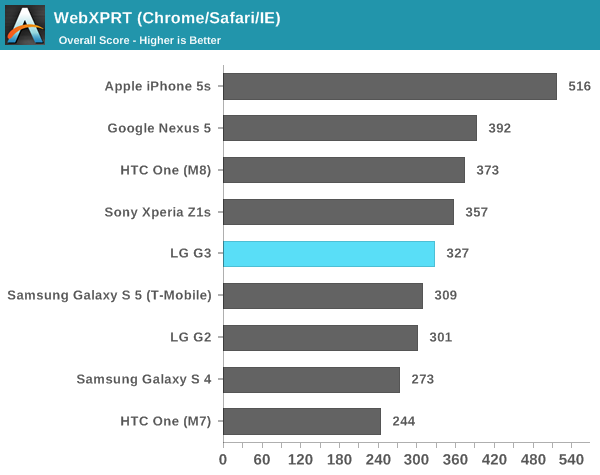
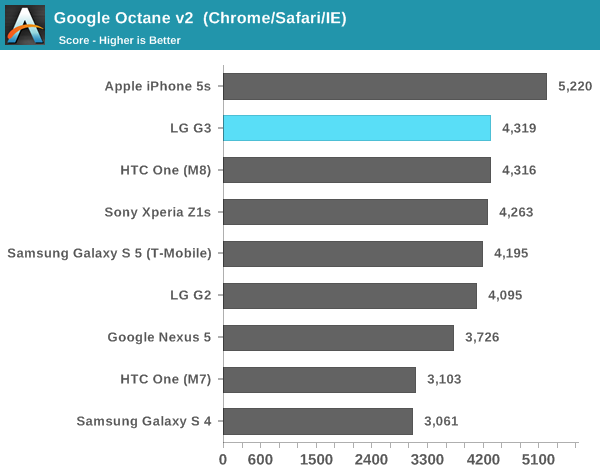
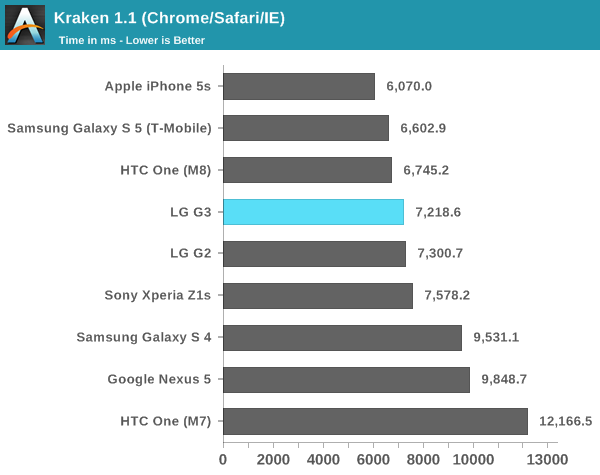
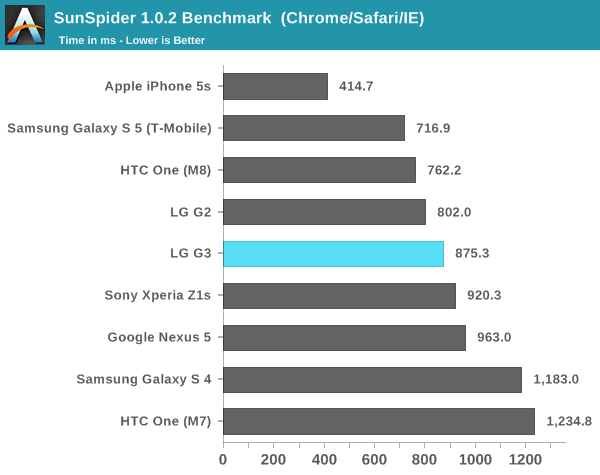
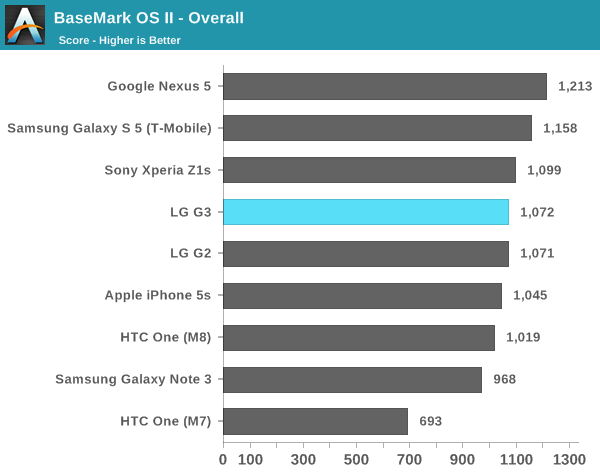
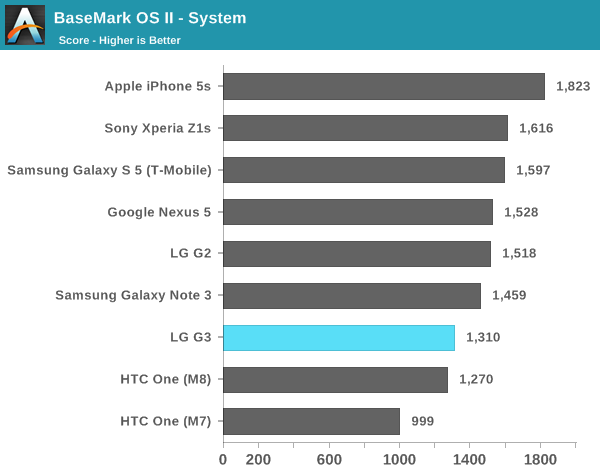
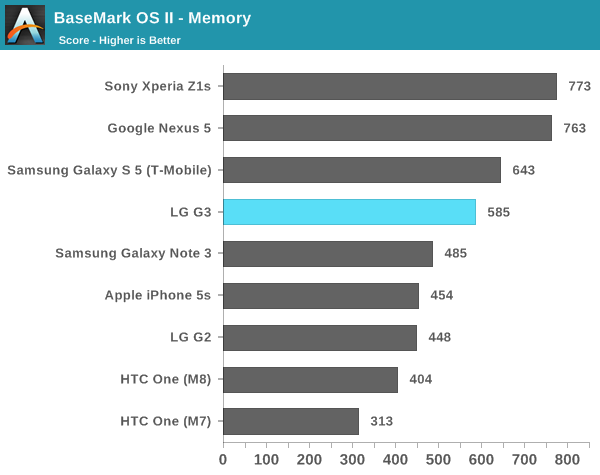

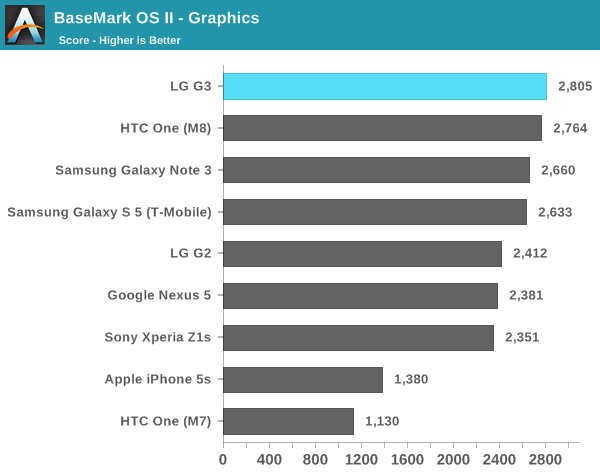
Relatively speaking, there's not much in the way of interesting things to talk about here, despite the new configuration. The G3 seems to trail the other S801 devices in web performance but it seems to depend upon the benchmark. This seems to be partially because of the G3's willingness to throttle, or because of the display's heat output. Either way, the trend is clear because of how often the display brightness is capped to 90 or 95 percent of the maximum to cool off the phone. When this isn't an issue though, the short benchmarks tend to show the faster performance of the G3.
GPU Performance
While the state of CPU benchmarking is heavily subject to difference in the performance of the web browser, things are a bit better in the GPU side. All Snapdragon 801 SoCs have the same GPU clocks, so this means that it'll be much easier to examine throttling behavior and reduce variability due to confounding factors.
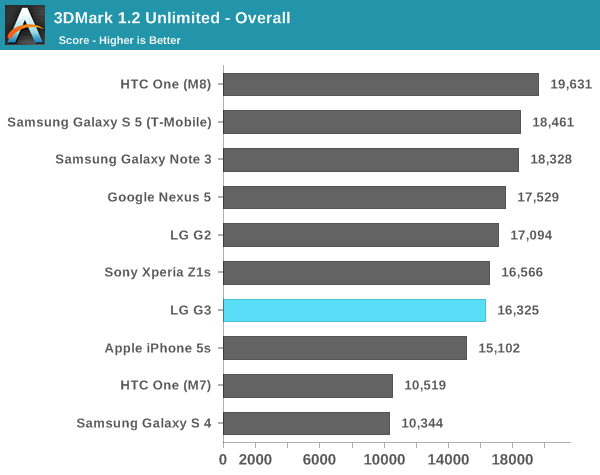
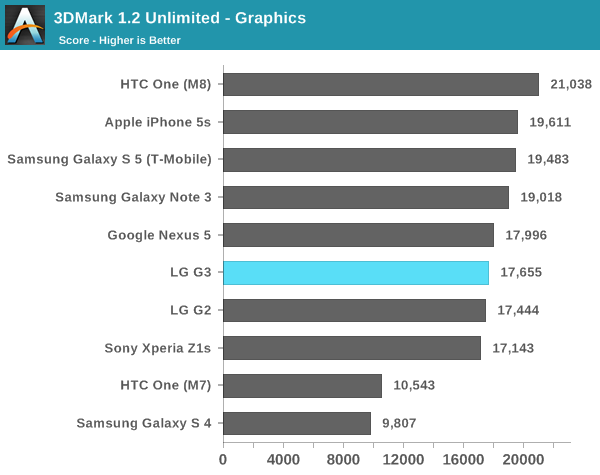

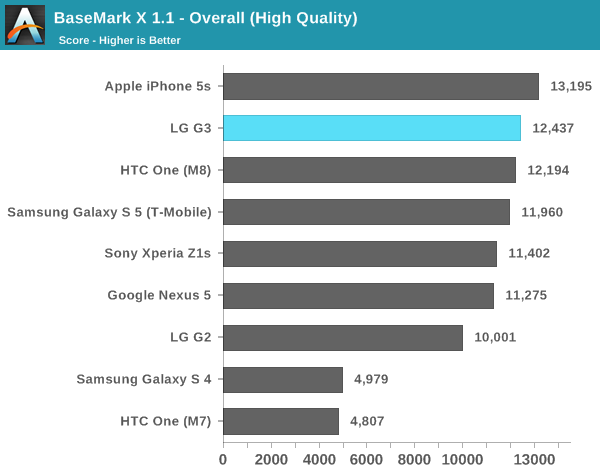
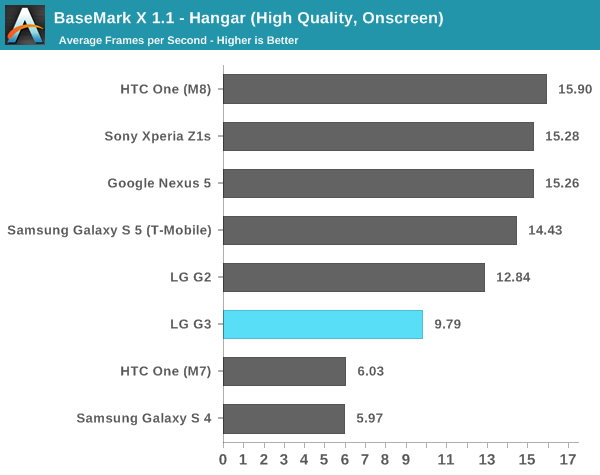
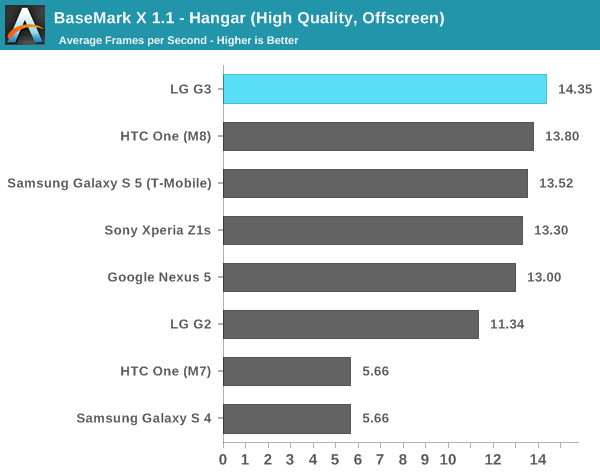
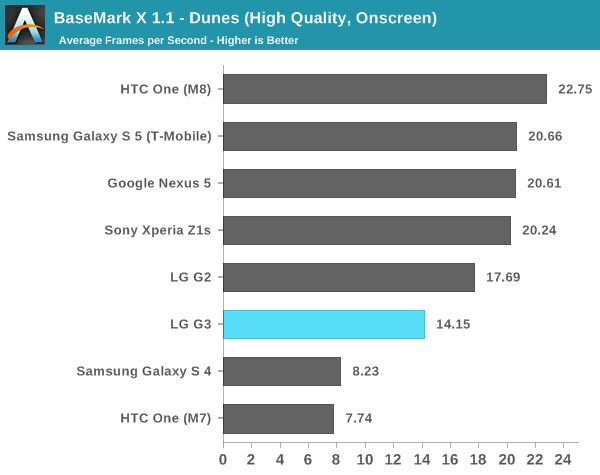
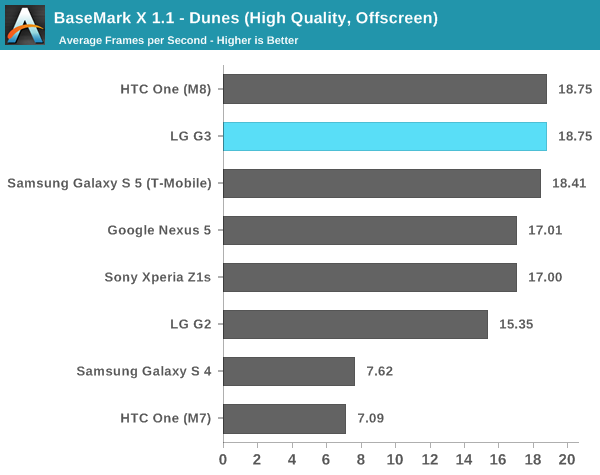
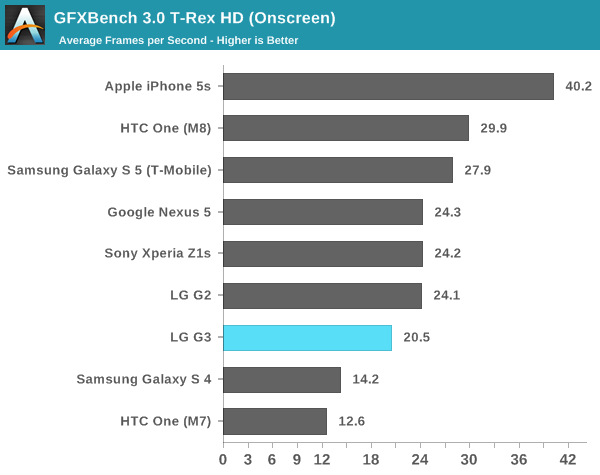
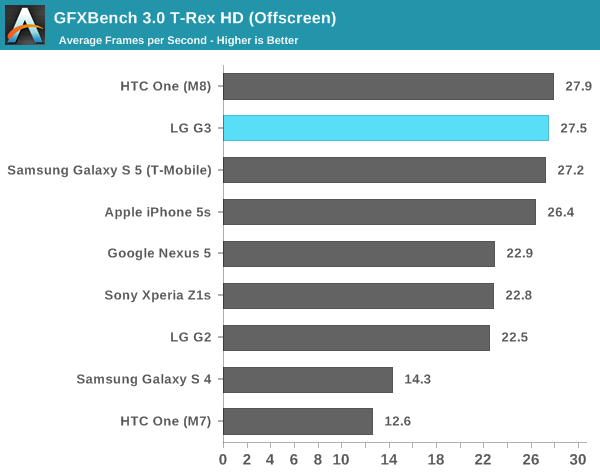
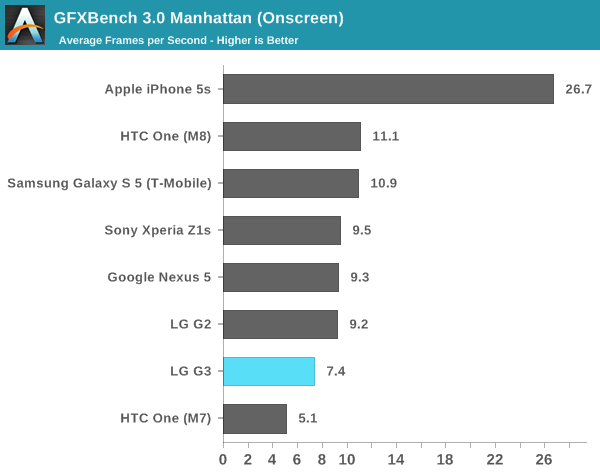
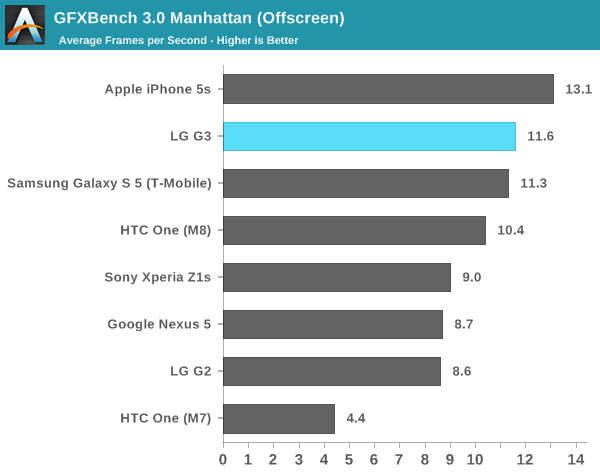
Here, we can see a noticeable trend. In the short tests, the LG G3 does great, easily nearing the top of the scores. However, 3DMark's extremely long-running test means that the G3 noticeably suffers in performance compared to the competition, and this is worsened by the G3's sinusoidal throttling patterns that cause significant degradation of performance for periods of time to balance out the high performance periods. On the on-screen tests, the G3 does worse than the high-end competition, which suggests that QHD/1440p truly does need Snapdragon 805's Adreno 420 in order to keep real-world performance from regressing relative to the Snapdragon 801, 1080p-screened counterparts.
NAND Performance
NAND performance used to be an afterthought, and effectively never discussed in most reviews. However, after the original Nexus 7 revealed the headaches that come with poor I/O performance this metric has increasingly come under greater scrutiny. To quantify this performance, we turn to Androbench with custom settings to evaluate Android smartphones.
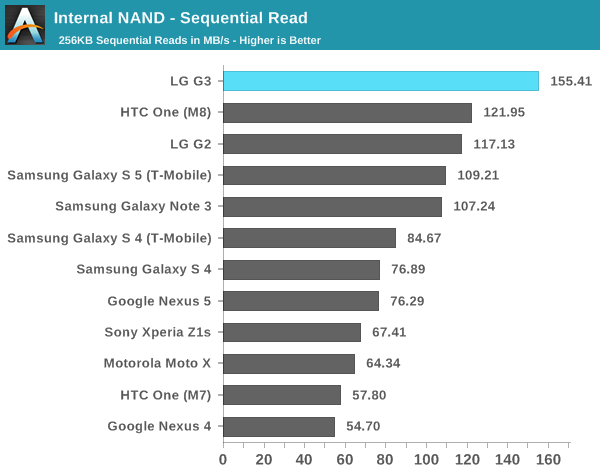
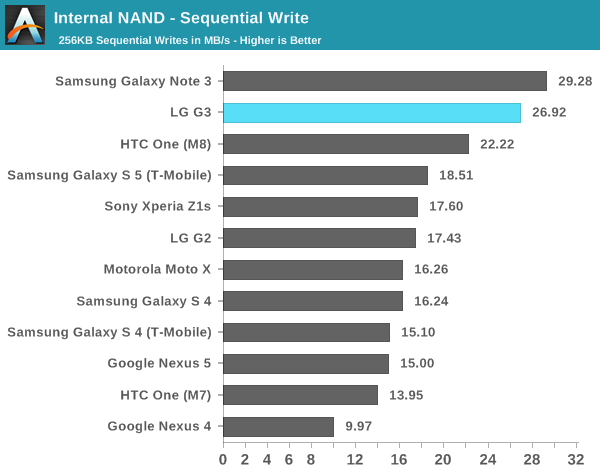
Here, the G3 is off to a great start. The sequential read speeds set new records and sequential write speeds are almost as good as it gets. This means that LG isn't cheaping out on NAND, which means that shooting 4K video and similarly intensive situations won't be a problem on the G3. However, random I/O performance is much more important as that's where people will notice poor performance in the form of stuttering and pauses.

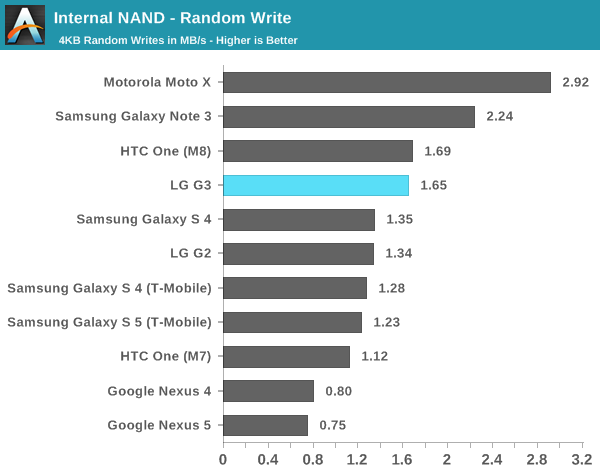
Here, we see a similar pattern. The LG G3 does great in random reads, but random write isn't quite as great. It's still perfectly usable and shouldn't present any problems for smoothness or general performance. The Moto X continues to hold its considerable lead here due to its F2FS file system that allows for much faster random I/O performance. Overall, the LG G3 shouldn't have any issues with I/O pauses, although you should still keep around 25% of your storage open to keep up I/O performance.










174 Comments
View All Comments
sherlockwing - Friday, July 4, 2014 - link
You listed Nexus 4 in the first Display Brightness graph then Nexus 5 in all the rest, could it be a typo?sherlockwing - Friday, July 4, 2014 - link
Nvm, I misread and didn't see Nexus 5.Niteowl360 - Friday, July 4, 2014 - link
Thank you for an awesome review.Technically better than most reviews whilst ensuring the layman remains in touch.
Only thing I found a little strange was the lack of excitement over the display.
Particularly most reviews have pointed to a slightly undersaturated display, in contrast to your findings.
Whilst your review states audio quality on per with the M8, I would have liked you to spend more time on this. After all we are still talking about a device which is primarily a phone!
I'm an HTC purist, but I believe HTC have continued to disappoint in the Camera department.
At the same time I believe the HTC logo and speakers however good, do come at an unacceptable wastage of display real estate.
I have always loved the realistic color saturation of HTC devices, and again raise reference to your findings on the over saturated G3 which seems to be a view shared by yourselves.
Thank you for an excellent overall review. Refreshingly detailed in substance.
Alexey291 - Sunday, July 6, 2014 - link
The display is of below average quality, albeit with higher resolution which reduces performance and battery life.Its a lot of tradeoffs for a small gimmick which is barely visible in reality.
zodiacfml - Friday, July 4, 2014 - link
Nahh, LG knew everything about this and just wants to compete with Samsung. How can LG beat Samsung's AMOLED display?I don't know but LG is probably not going the OLED route because Samsung's tech is superior.
peterfares - Friday, July 4, 2014 - link
This phone looks really awesome, especially finally going back to removable battery and SD card.But what's putting my off is the QHD screen. It's just a waste in every way. Waste of money. Waste of battery power. Waste of CPU and GPU resources. Waste of RAM. Shame. Everything else about this phone is AWESOME.
flyingpants1 - Friday, July 4, 2014 - link
Having onscreen buttons costs you 7% in screen are, and defeats the whole purpose of having a larger screen.Buttons should be capacitive, no bezel, and the browser UI and notification area should be cut down by about half.
Should have made a G2 with front speakers..A
UpSpin - Friday, July 4, 2014 - link
I disagree with you. On screen buttons vanish in full screen apps like games, video players, browser if you like, photo viewer, ... so practically no screen area is lost at all.On screen buttons allow a larger level of customization if you root. For example left right arrow in text fields once the keyboard shows up.
On screen buttons allow edge to edge displays. So practically you get a larger usable display at a smaller physical smartphone size.
If you feel too much space is wasted, I recommend you to root your smartphone, reduce the lcd density value, reduce the on screen button size and use the immersive mode of android.
Death666Angel - Saturday, July 5, 2014 - link
My on-screen buttons disappear when I'm not using them and almost all apps are good enough to use that space to display more stuff. Only means I have to swipe up or down to active them again, which hasn't been a hassle when using the G2 for the past 2 months. The design is much nicer as a result as well. My wifes SGS3 looks so ancient even compared to my Galaxy Nexus.Cruisecontrol - Friday, July 4, 2014 - link
Too bad about the display. That was one of the things I was hoping would make this phone stand out. I guess I'll have to wait to see if Samsung delivers an S5 Prime and what that has to offer.